Jeremiah Sisson, ca. 1720 - 1783
Stephen Charles Triboudet Demainbray, 1710 - 1782
by Brian Stevenson
last updated February, 2021
Although Jeremiah Sisson appears to have made only a small number of microscopes, they are so distinctively elegant and attractive that they deserve to be widely shared (Figures 1 and 2). Sisson had a shop on The Strand, London, primarily producing astronomical, surveying, and navigational instruments.
Circa 1756, Sisson was engaged to produce microscopes according to a design by Stephen Demainbray, who was tutor to the Prince of Wales (the future King George III). Demainbray described it as "Apparatus contained within the compass of a snuff box to be used in the single, compound, and may occasionally be used in the solar way, this contrivance not only contains whatever is useful to the various purposes ... but is perfectly sturdy and strong in all its parts".
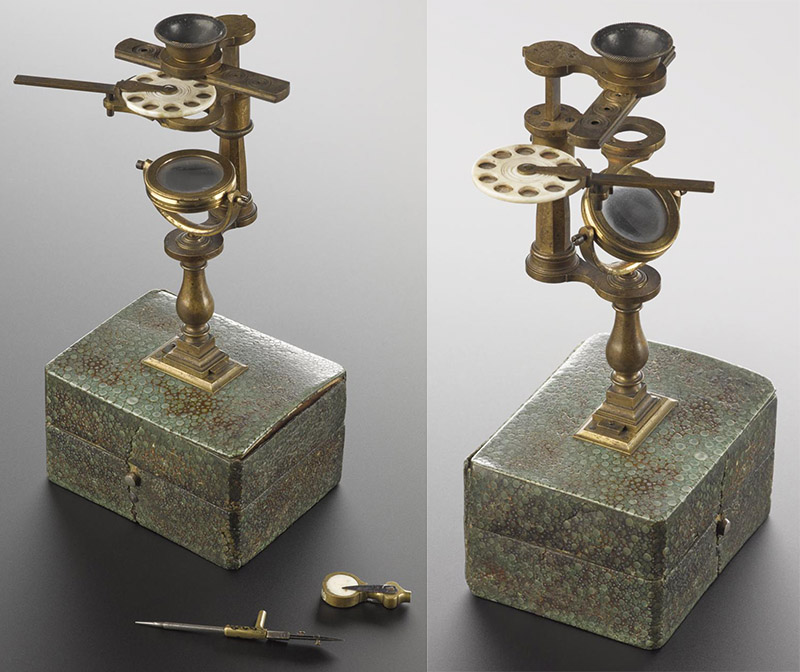
Figure 1.
One of two known examples of Jeremiah Sisson's microscopes, inscribed "Dr. Demainbray invent" and "J. Sisson London". It could be used as either a simple microscope and a compound microscope. Clay and Court described the microscope, "It has six powers in a sliding dove-tail bar, which fits in a groove under the eye-cap. It has a number of objects mounted on a disc such as was supplied by Matthew Loft with his Culpeper microscopes. ... The instrument packs into the shagreen case upon which it is mounted in the photograph. The upper part, above the support for the mirror, can be screwed off and held in the hand, being directed towards the sky". It originally included a compound body, which is now missing. A second example is shown in the Catalog of the Billings Microscope Museum (page 12, Figure 22). That example includes its compound body, described as having a "drawtube 2 1/2 inches long, 1/2 inch diameter, with sliding lens cap; there is no field lens". The box measures 85mm wide by 65mm deep by 50 mm high (3 1/2 x 2 1/2 x 2 inches). Assembled, the microscope plus case is 200 mm (8 inches) tall as a simple microscope. A similar microscope, also designed by Demainbray but built by Thomas Bureau, is engraved with the date "1756"; I have not located pictures of the Bureau instrument (see below). Adapted for nonprofit-educational purposes from http://collection.sciencemuseum.org.uk/objects/co2406/pocket-microscope-by-sisson-in-green-shagreen-case-with-brass-slde-wheel-of-objects-and-stage-forceps.
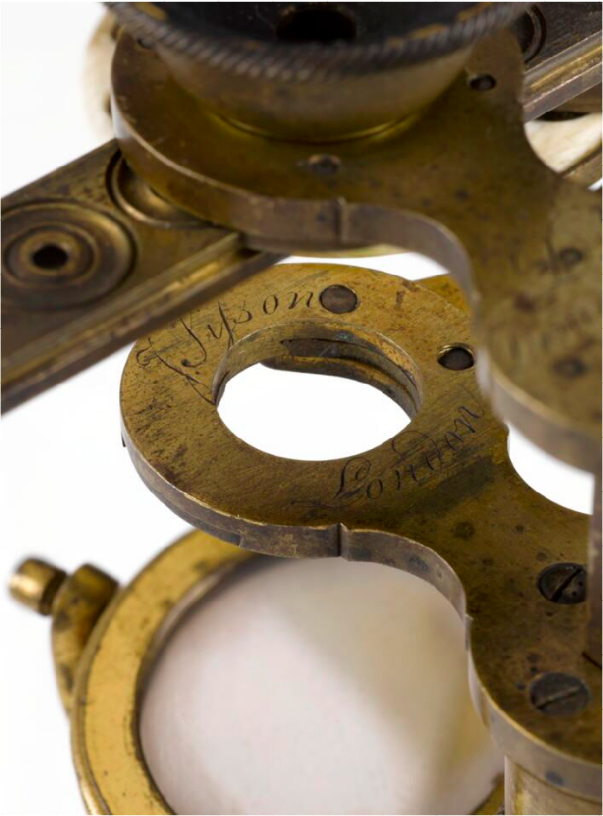
Figure 2.
Sisson's signature (as "Syson"), on the stage of the microscope. Adapted for nonprofit-educational purposes from http://collection.sciencemuseum.org.uk/objects/co2406/pocket-microscope-by-sisson-in-green-shagreen-case-with-brass-slde-wheel-of-objects-and-stage-forceps.
Jeremiah Sisson was christened on December 14, 1720, at Carter Lane Blackfriars, London. He is presumed to have been born earlier in that year. His father, Jonathan Sisson (ca. 1690 - 1747), was a maker of optical and scientific instruments. In 1822, Jonathan set up a shop in Beaumont's Buildings, The Strand. During 1729, he was appointed Mathematical Instrument Maker to Frederick, Prince of Wales (1707 - 1751), father of the future King George III.
Jeremiah trained with his father, and succeeded him in business at the same location. He became one of the most highly skilled instrument makers in London, producing sectors and other astronomical instruments to the Royal Observatory at Greenwich, the Brera Observatory in Milan, and others. Sisson's employees included Jesse Ramsden (1762 - 1800), who also achieved fame for his skill as an instrument-maker (and was brother-in-law to Peter Dollond and master to William Cary, among other feats).
However, Sisson was a poor businessman. It was said that he "began too many projects but completed none". Sisson filed for bankruptcy protection in 1751, and again in 1775. He succeeded George Adams, Sr., as supplier to the Board of Ordnance in 1772, but lost the appointment after his 1775 bankruptcy. Nonetheless, Sisson remained in demand and was taking orders until near the time of his death.
Demainbray was trained in a range of scientific fields, and was a skilled lecturer and experimenter. He was appointed Astronomer to the Observatory at Kew in 1768, and retained that office for the rest of his life. Thus, he would have been well aware of Sisson's skills as a master craftsman. It is not known whether or not Sisson made any other types of microscopes. It also appears to not be known why the otherwise-anonymous Thomas Bureau was contracted to build a similar Demainbray-designed microscope, or which of those instruments was made first.
Demainbray's father, Stephen Triboudet, fled from France to Holland after the 1685 Edict of Fontainebleau (which revoked the right of Huguenots to practice their religion without persecution). He then moved to England with William of Orange / King William III. Triboudet died in 1710, soon after his son was born.
Stephen Demainbray was sent by his uncle, Captain Demainbray, to board at the Westminster School with mathematician Theophilus Desaguliers. Stephen married in 1727, then went to study in Leiden. He moved to Edinburgh, lecturing in "experimental philosophy", and taking a Doctor of Laws degree.
Also while in Edinburgh, he discovered an influence of electricity in stimulating the growth of plants. Priestley reported, "Mr. Maimbray at Edinburgh electrified two myrtle-trees during the whole month of October 1746, when they put forth small branches and blossoms sooner than other shrubs of the same kind which had not been electrified".
During the Jacobite Rising of 1745, Demainbray served as a volunteer in the English army.
He resumed his academic work in 1746, while also operating a girls' boarding-school. Several moves followed: ca. 1748 to Dublin for a year and a half of lecturing, then to Bordeaux for a short time on the invitation of the Royal Academy, then to Montpelier, where he became a member of the Academie des Sciences of Paris. After his wife's death in 1750, Demainbray returned to England to become tutor of mathematics, experimental philosophy, and natural history to the Prince of Wales (the future King George III).
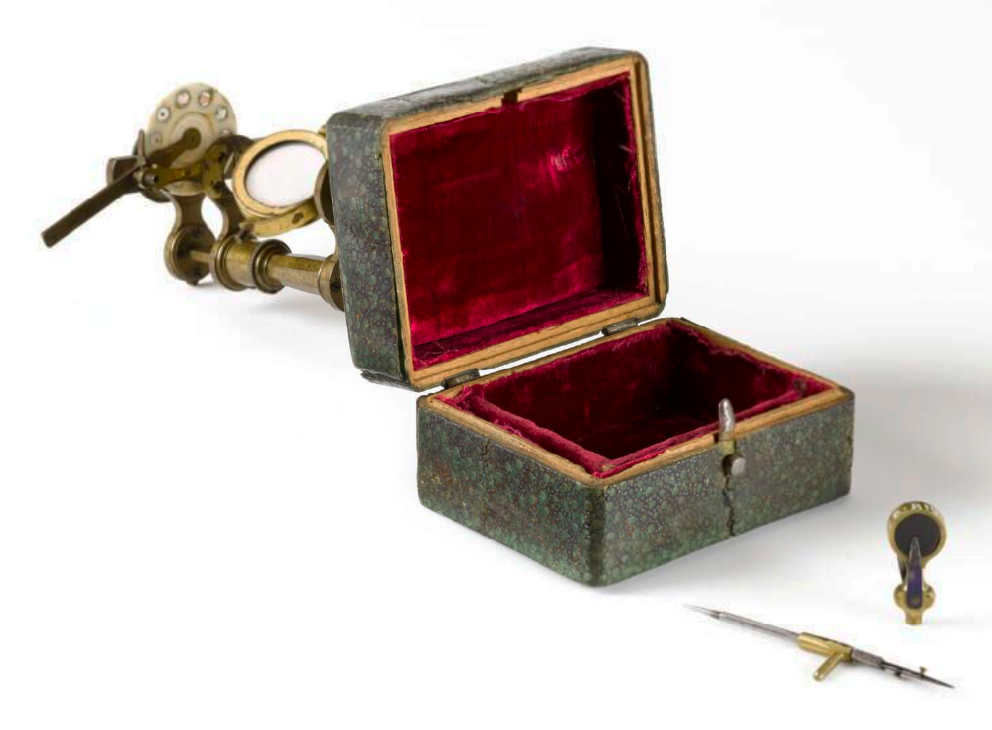
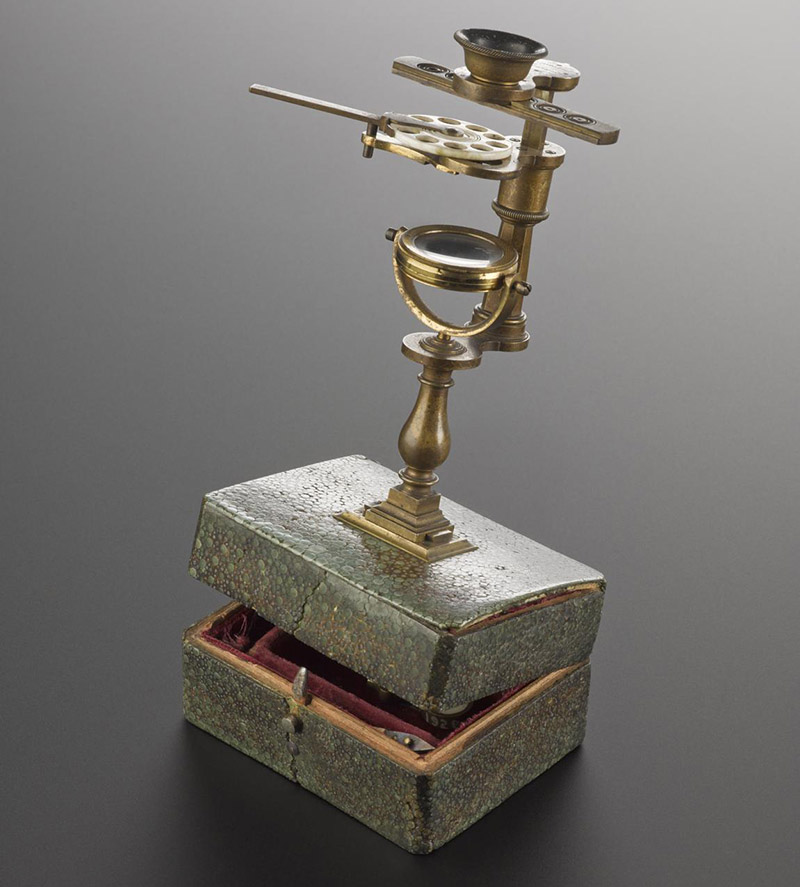
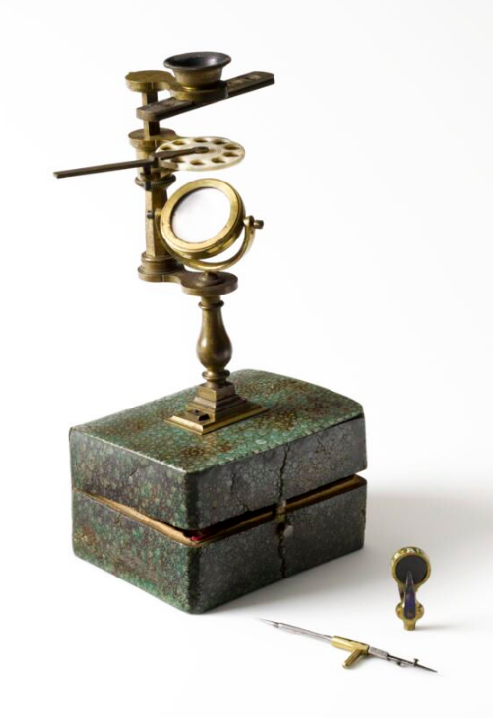
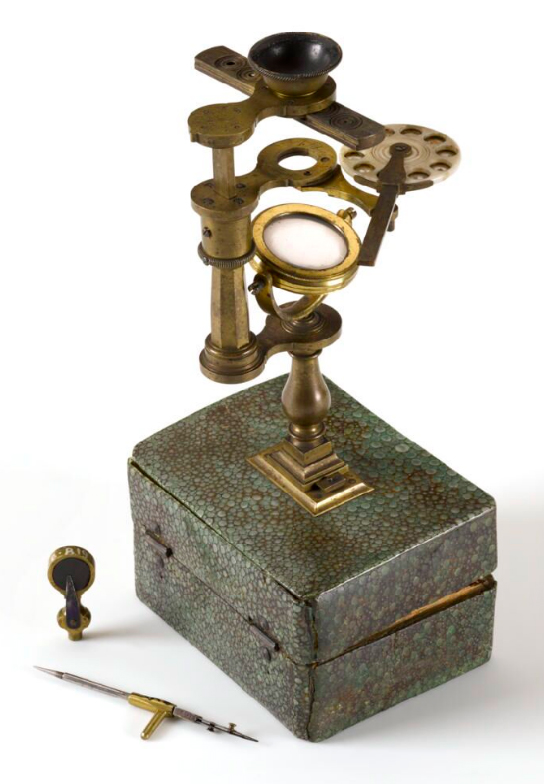
Figure 3.
Additional views of the Science Museum's Sisson-Demainbray microscope. Adapted for nonprofit-educational purposes from http://collection.sciencemuseum.org.uk/objects/co2406/pocket-microscope-by-sisson-in-green-shagreen-case-with-brass-slde-wheel-of-objects-and-stage-forceps.
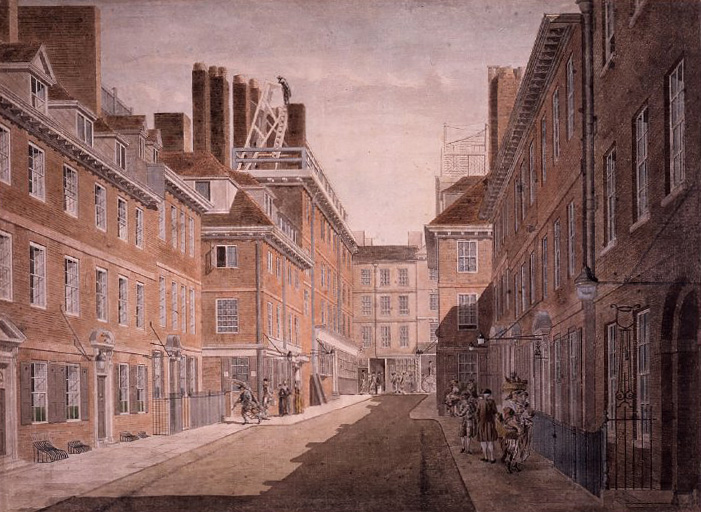
Figure 4.
The Strand, during the 1700s. Beaumont's Buildings, which housed the businesses of Jonathan and Jeremiah Sisson, is on the left, on the corner at the intersection with the distant cross-street. The white angular object on the roof is one of Sisson's astronomical instruments. Adapted for nonprofit, educational purposes from http://www.britishmuseum.org/research/collection_online/collection_object_details.aspx?objectId=751261&partId=1.

Figure 5.
Trade card of Jeremiah Sisson's father, Jonathan. Adapted for nonprofit, educational purposes from http://www.britishmuseum.org/research/collection_online/collection_object_details/collection_image_gallery.aspx?assetId=420353001&objectId=3085786&partId=1#more-views.
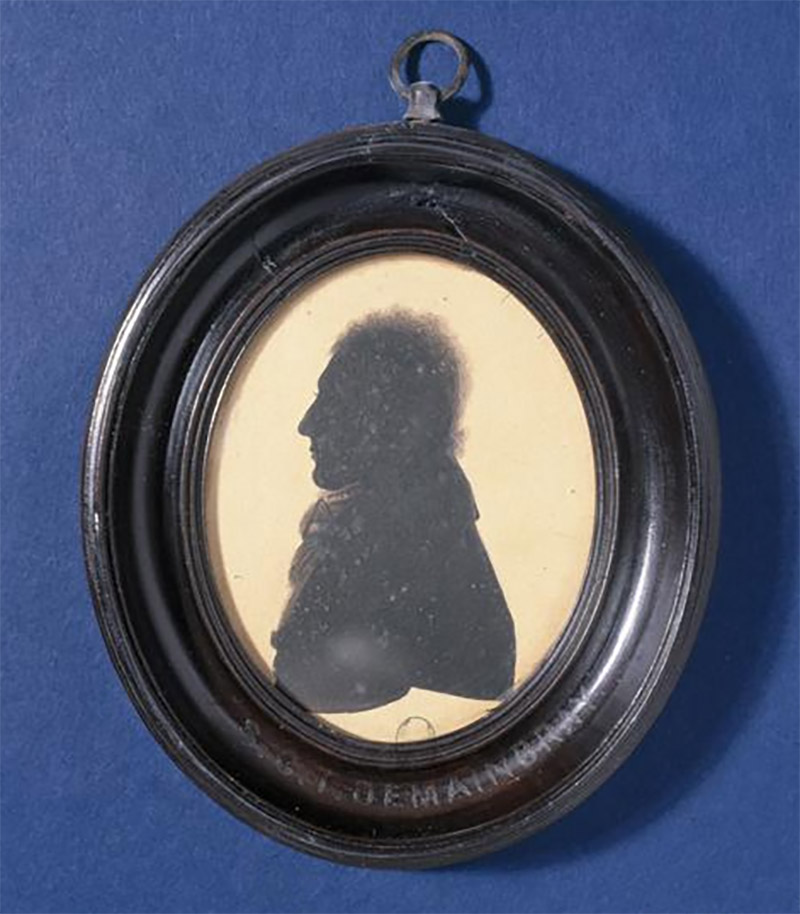
Figure 6.
Silhouette of Stephen Demainbray. Adapted for nonprofit, educational purposes from http://collectionsonline.nmsi.ac.uk/detail.php?t=objects&type=browse&f=CATEGORY1&s=SCM+-+Microscopes&record=699.
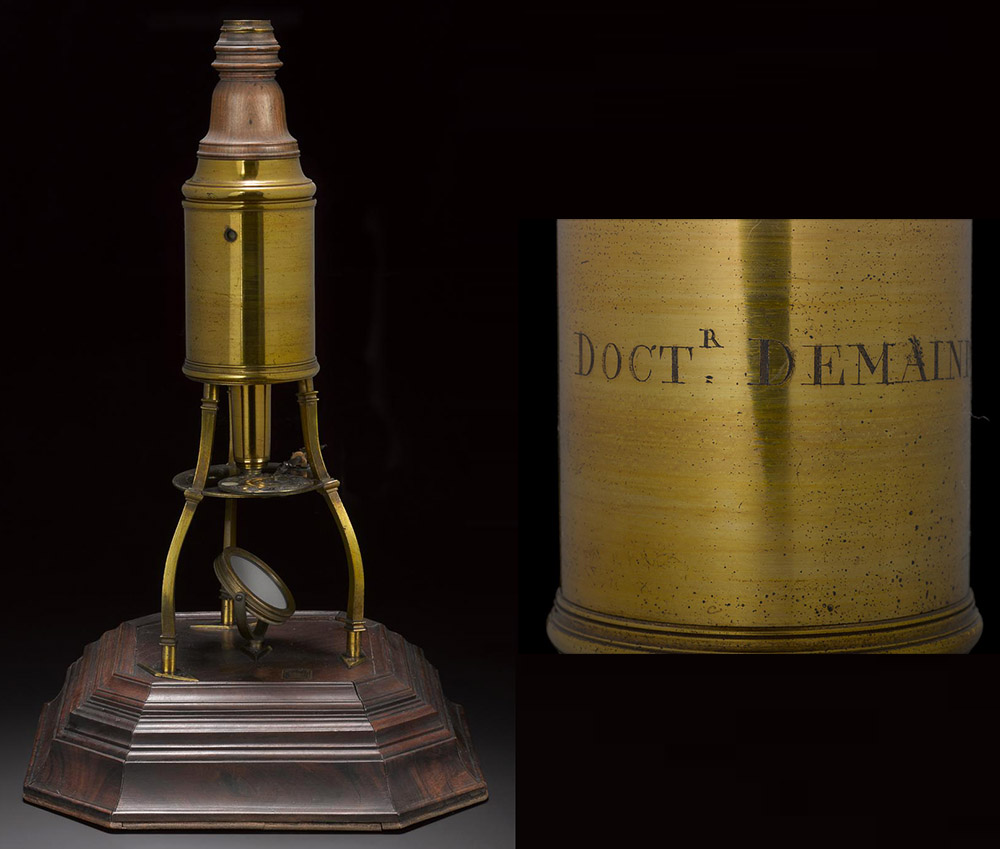
Figure 7.
A "Culpeper"-type that was made for Stephen Demainbray in 1745 by either Matthew Loft or Edward Scarlett in London. Adapted for nonprofit, educational purposes from https://collection.sciencemuseumgroup.org.uk/objects/co8433/demainbrays-compound-microscope-microscope .
Note on the Demainbray microscope by Thomas Bureau
The Museum of the History of Science (UK) holds this microscope, but has not published photographs. It has inventory nunber 49766, described as:
Signed 'Thos. Bureau Fecit' and 'Dr: Demainbray invt 1756'. Brass, etc., in wooden box covered with fishskin. Minimum mounted height 210mm.; box 88 x 72 x 44mm.
This microscope represents an early attempt to design a compound microscope sufficiently small to be carried in a little box in the pocket, like the simple microscopes of Lindsay and others. These latter always provided the most successful solutions to the demand; and not until the Gould type microscope in the 1820s was there a pocket compound microscope which found a wide market.
This elegant and very well made little instrument was designed by Stephen Demainbray, astronomer to King George III at Kew Observatory, and made for the Royal collection (possibly the only one produced). It was purchased from the Kew collection by Sir Frank Crisp.
http://www.mhs.ox.ac.uk/collections/imu-search-page/narratives/?irn=5762&index=0
Acknowledgments
Many thanks to Joe Zeligs for his advice and continued support of this history project.
Resources
The Billings Microscope Collection of the Medical Museum Armed Forces Institute of Pathology (1974) Second edition, page 12 and figure 22
Clay, Reginald S., and Thomas H. Court (1932) The History of the Microscope, Charles Griffin and Co., London, pages 61 and 121, plate 81
Clifton, Gloria (1995) Directory of British Scientific Instrument Makers 1550-1851, Zwemmer, London, pages 43, 227-228 and 253
England birth, marriage, poll book, and other records, accessed through ancestry.com
Howse, Derek (2004) Sisson, Jeremiah, Oxford Dictionary of National Biography, Oxford University Press
Howse, Derek (2004) Sisson, Jonathan, Oxford Dictionary of National Biography, Oxford University Press
Macray, William Dunn (1888) Demainbray, Stephen Charles Triboudet, Dictionary of National Biography, Vol. 14, pages 780-781
McConnell, Anita (2016) Jesse Ramsden (1735 - 1800): London's Leading Scientific Instrument Maker, Ashgate, London
Morton, Alan Q., Jane A. Wess (1993) Public & Private Science: the King George III Collection, Oxford University Press, Oxford (Sisson microscope described and illustrated on page 194)
The Universal Magazine of Knowledge and Pleasure (1775) Announcement of the bankruptcy of Jeremiah Sisson, page 167
Whipple, Robert (1930) Some Scientific Instrument Makers of the 18th Century, Nature, Vol. 126, pages 283-286
Will of Jeremiah Sisson (1783) accessed through ancestry.com
Will of Stephen Demainbray (1782) accessed through ancestry.com









